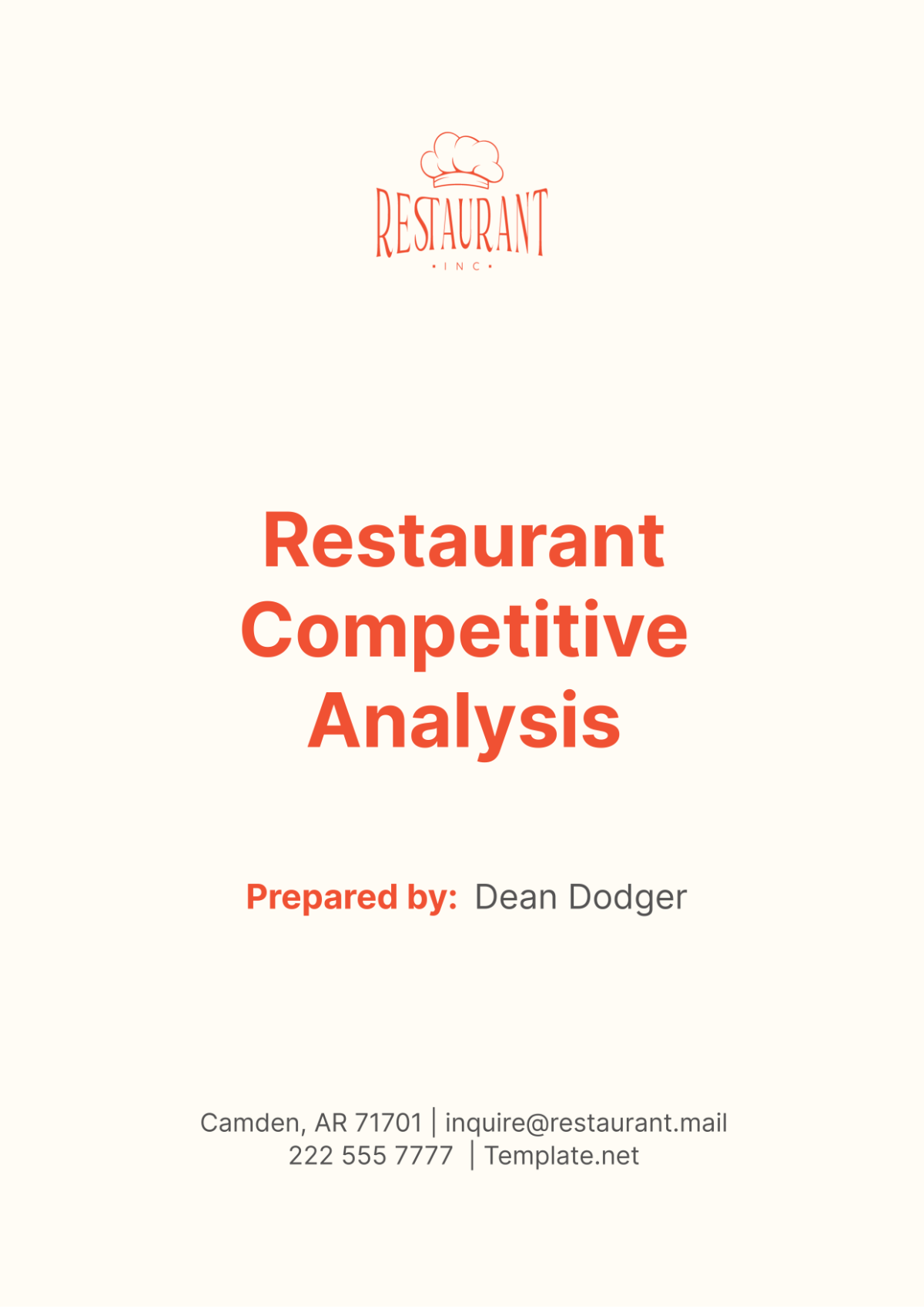Free Restaurant Competitive Analysis

I. Executive Summary
A. Overview
[Your Company Name], a leading restaurant chain specializing in gourmet burgers, has undertaken a detailed competitive analysis of the restaurant industry to gain insights into market dynamics and enhance strategic decision-making.
This report presents findings from extensive research conducted on key competitors, market trends, and customer preferences, aiming to identify opportunities for growth and differentiation within the competitive landscape.
The analysis covers aspects such as market share, customer demographics, pricing strategies, menu offerings, and marketing approaches, providing valuable insights for [Your Company Name]'s future business strategies.
B. Introduction
The primary objective of this competitive analysis is to equip [Your Company Name] with actionable insights into the competitive landscape of the restaurant industry.
By examining the strategies and performance of major competitors, [Your Company Name] aims to refine its own strategies, optimize offerings, and enhance competitiveness in the market.
The analysis will serve as a foundation for strategic planning, marketing initiatives, and operational improvements to drive growth and profitability.
II. Methodology
A. Data Collection
Primary Research
1.1 Surveys: [Your Company Name] conducted surveys among restaurant-goers across various demographics to gather insights into dining preferences, satisfaction levels, and brand perceptions.
1.2 Interviews: In-depth interviews were conducted with restaurant owners, managers, and industry experts to gain firsthand knowledge of industry trends, challenges, and success factors.
Secondary Research
2.1 Market Reports: [Your Company Name] reviewed industry reports from reputable sources such as IBISWorld, Statista, and National Restaurant Association to gather data on market size, growth projections, and competitive dynamics.
2.2 Online Reviews: Analysis of customer reviews and ratings on popular review platforms like Yelp, Google Reviews, and TripAdvisor provided additional insights into customer experiences and sentiments.
B. Analysis Framework
Competitor Identification
1.1 [Competitor 1 Name]: A nationally recognized fast-casual burger chain with a strong presence in urban areas.
1.2 [Competitor 2 Name]: A family-owned upscale steakhouse known for its high-quality meats and fine dining experience.
1.3 [Competitor 3 Name]: A trendy vegan restaurant offering plant-based dishes and environmentally conscious dining options.
Key Metrics
2.1 Market Share: Analyzing revenue figures, foot traffic data, and customer surveys to assess each competitor's market share within the restaurant industry.
2.2 Customer Satisfaction: Evaluating online reviews, customer feedback, and satisfaction scores to gauge the level of satisfaction with each competitor's products and services.
2.3 Pricing Strategy: Comparing menu prices, discounts, and promotional offers to understand each competitor's pricing strategy and positioning within the market.
2.4 Menu Offering: Analyzing menu diversity, specialty items, and unique offerings to identify strengths and areas for improvement in each competitor's menu.
2.5 Marketing and Promotions: Reviewing advertising campaigns, social media presence, and promotional activities to assess the effectiveness of each competitor's marketing efforts.
III. Competitive Landscape
A. Market Share Analysis
Competitor | Market Share (%) |
|---|---|
Competitor 1 | [25%] |
Competitor 2 | [30%] |
Competitor 3 | [20%] |
[Your Company] | [25%] |
B. Customer Demographics
Target Audience Profile
1.1 Age Distribution
Competitor 1: Primarily targets millennials and young professionals aged 18-35.
Competitor 2: Caters to an older demographic, with a focus on middle-aged and affluent customers aged 35-55.
Competitor 3: Appeals to a diverse age group but has a strong following among Generation Z and millennials aged 18-30.
1.2 Income Levels
Competitor 1: Targets middle-income earners with disposable income for casual dining experiences.
Competitor 2: Appeals to higher-income individuals seeking upscale dining experiences and willing to pay premium prices.
Competitor 3: Attracts both middle-income earners and affluent customers interested in healthy and sustainable dining options.
1.3 Geographic Location
Competitor 1: Concentrated in urban areas and busy commercial districts.
Competitor 2: Predominantly located in suburban and upscale neighborhoods.
Competitor 3: Found in trendy urban neighborhoods and environmentally conscious communities.
C. Pricing Strategy
Competitor | Average Price ($) |
|---|---|
Competitor 1 | [$15] |
Competitor 2 | [$40] |
Competitor 3 | [$20] |
[Your Company] | [$18] |
D. Menu Offering
Menu Diversity
1.1 Cuisine Types
Competitor 1: Offers a diverse menu with a focus on American classics such as burgers, sandwiches, and salads.
Competitor 2: Specializes in steak and seafood dishes, with a limited but high-quality menu featuring premium cuts and seasonal ingredients.
Competitor 3: Features a creative menu of plant-based dishes, vegan burgers, salads, and smoothies, catering to health-conscious and environmentally aware consumers.
1.2 Dietary Options
Competitor 1: Provides vegetarian and gluten-free options but with limited variety compared to other competitors.
Competitor 2: Offers a few vegetarian and gluten-free dishes but primarily focuses on meat-centric offerings.
Competitor 3: Proudly promotes a fully plant-based menu with options suitable for vegans, vegetarians, and those with dietary restrictions.
1.3 Specialty Items
Competitor 1: Known for signature burgers with unique toppings and flavor combinations.
Competitor 2: Features aged steaks and seafood delicacies as its specialty items, appealing to discerning palates.
Competitor 3: Highlights innovative vegan creations such as Beyond Meat burgers, jackfruit tacos, and dairy-free desserts.
IV. Competitor Analysis
A. Competitor 1 Analysis
Overview
1.1 Business Model: Competitor 1 operates as a fast-casual restaurant chain with a focus on high-quality ingredients and customizable menu options.
1.2 Unique Selling Proposition: Known for its fast service, trendy ambiance, and Instagram-worthy food presentation.
1.3 Strengths and Weaknesses: Strengths include widespread brand recognition and a loyal customer base, while weaknesses may include limited menu innovation and reliance on traditional marketing channels.
Marketing Strategy
2.1 Advertising Channels: Utilizes social media platforms, influencer partnerships, and local events to engage with target audiences.
2.2 Promotional Activities: Offers loyalty programs, seasonal promotions, and discounts to attract and retain customers.
2.3 Branding Approach: Emphasizes a youthful and energetic brand image through vibrant branding elements and modern décor.
B. Competitor 2 Analysis
Overview
1.1 Business Model: Competitor 2 operates as an upscale steakhouse and fine dining establishment, targeting affluent customers seeking premium dining experiences.
1.2 Unique Selling Proposition: Distinguishes itself through its commitment to sourcing the finest quality meats, personalized service, and elegant ambiance.
1.3 Strengths and Weaknesses: Strengths include a reputation for culinary excellence and impeccable service, while weaknesses may include limited appeal to budget-conscious diners and potential vulnerability to economic downturns.
Marketing Strategy
2.1 Advertising Channels: Focuses on traditional advertising channels such as print media, luxury lifestyle magazines, and exclusive events.
2.2 Promotional Activities: Offers prix-fixe menus, wine pairing dinners, and exclusive membership programs to enhance customer loyalty and attract high-value clientele.
2.3 Branding Approach: Projects an image of sophistication, refinement, and exclusivity through upscale branding materials, refined décor, and attention to detail in every aspect of the dining experience.
C. Competitor 3 Analysis
Overview
1.1 Business Model: Competitor 3 operates as a trendy vegan restaurant, appealing to health-conscious consumers, vegans, and environmentally conscious diners.
1.2 Unique Selling Proposition: Stands out for its innovative plant-based menu, commitment to sustainability, and vibrant, Instagram-friendly dishes.
1.3 Strengths and Weaknesses: Strengths include a niche market positioning and growing demand for plant-based dining options, while weaknesses may include limited mainstream appeal and higher ingredient costs.
Marketing Strategy
2.1 Advertising Channels: Leverages social media platforms, influencer collaborations, and partnerships with eco-conscious organizations to reach target audiences.
2.2 Promotional Activities: Hosts vegan cooking classes, pop-up events, and wellness workshops to engage with the community and promote its brand values.
2.3 Branding Approach: Projects a hip and modern brand image through colorful branding materials, eco-friendly packaging, and a commitment to ethical sourcing and sustainability practices.
V. Recommendations
A. Opportunities for Differentiation
Menu Innovation
1.1 Introduce unique burger creations inspired by global cuisines to attract adventurous diners.
1.2 Expand vegetarian and vegan options to cater to the growing demand for plant-based alternatives.
Customer Experience Enhancement
2.1 Implement a digital ordering system and mobile app for streamlined ordering and pickup/delivery options.
2.2 Enhance restaurant ambiance with interactive elements, live music, or themed dining experiences to create memorable moments for customers.
Marketing and Promotion Strategies
3.1 Launch targeted social media campaigns highlighting special promotions, new menu items, and behind-the-scenes glimpses of kitchen operations.
3.2 Collaborate with local influencers and food bloggers to increase brand visibility and credibility within the community.
B. Target Market Expansion
Geographic Expansion
1.1 Identify key cities and neighborhoods with high foot traffic and demand for gourmet dining experiences for potential expansion.
1.2 Explore franchising opportunities to enter new markets while leveraging local expertise and resources.
Niche Market Targeting
2.1 Develop tailored menu offerings or themed events targeting specific demographics such as families, health enthusiasts, or foodies.
2.2 Partner with fitness centers, wellness spas, or corporate offices to offer catering services or meal packages tailored to health-conscious consumers.
C. Strategic Partnerships
Suppliers Collaboration
1.1 Source ingredients locally whenever possible to support sustainable farming practices and reduce carbon footprint.
1.2 Establish long-term partnerships with trusted suppliers to ensure consistent quality and availability of ingredients.
Cross-Promotional Opportunities
2.1 Partner with complementary businesses such as breweries, wineries, or dessert shops to offer joint promotions or menu pairings.
2.2 Collaborate with community organizations or charity events to sponsor fundraisers or donate a portion of sales to local causes.
VI. Conclusion
A. Summary of Findings
The competitive analysis has provided valuable insights into the restaurant industry, highlighting key competitors' strengths, weaknesses, and market positioning. [Your Company Name] is well-positioned to capitalize on emerging opportunities and differentiate itself through menu innovation, customer experience enhancements, and strategic partnerships.
B. Implications for [Your Company Name]
The findings of this analysis will guide [Your Company Name] in refining its business strategies, optimizing menu offerings, and enhancing marketing efforts to attract and retain customers in a competitive market landscape.
C. Next Steps
Moving forward, [Your Company Name] will focus on implementing the recommended strategies, monitoring market trends, and staying agile to adapt to evolving consumer preferences and industry dynamics. By leveraging its strengths and addressing areas for improvement, [Your Company Name] is poised for continued growth and success in the restaurant industry.
- 100% Customizable, free editor
- Access 1 Million+ Templates, photo’s & graphics
- Download or share as a template
- Click and replace photos, graphics, text, backgrounds
- Resize, crop, AI write & more
- Access advanced editor
Stay ahead of the competition with Template.net's Restaurant Competitive Analysis Template. This customizable document provides a structured format for analyzing your competitors' strengths, weaknesses, market positioning, and strategies. Identify opportunities and threats in the market to refine your competitive strategy. Editable in our Ai Editor Tool for seamless customization to fit your competitive analysis requirements and business insights.





























